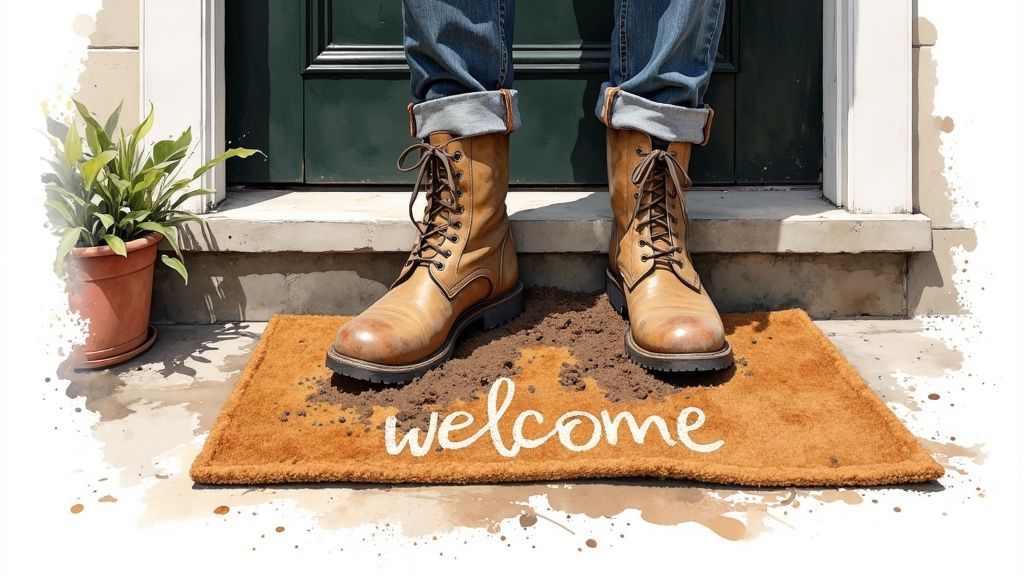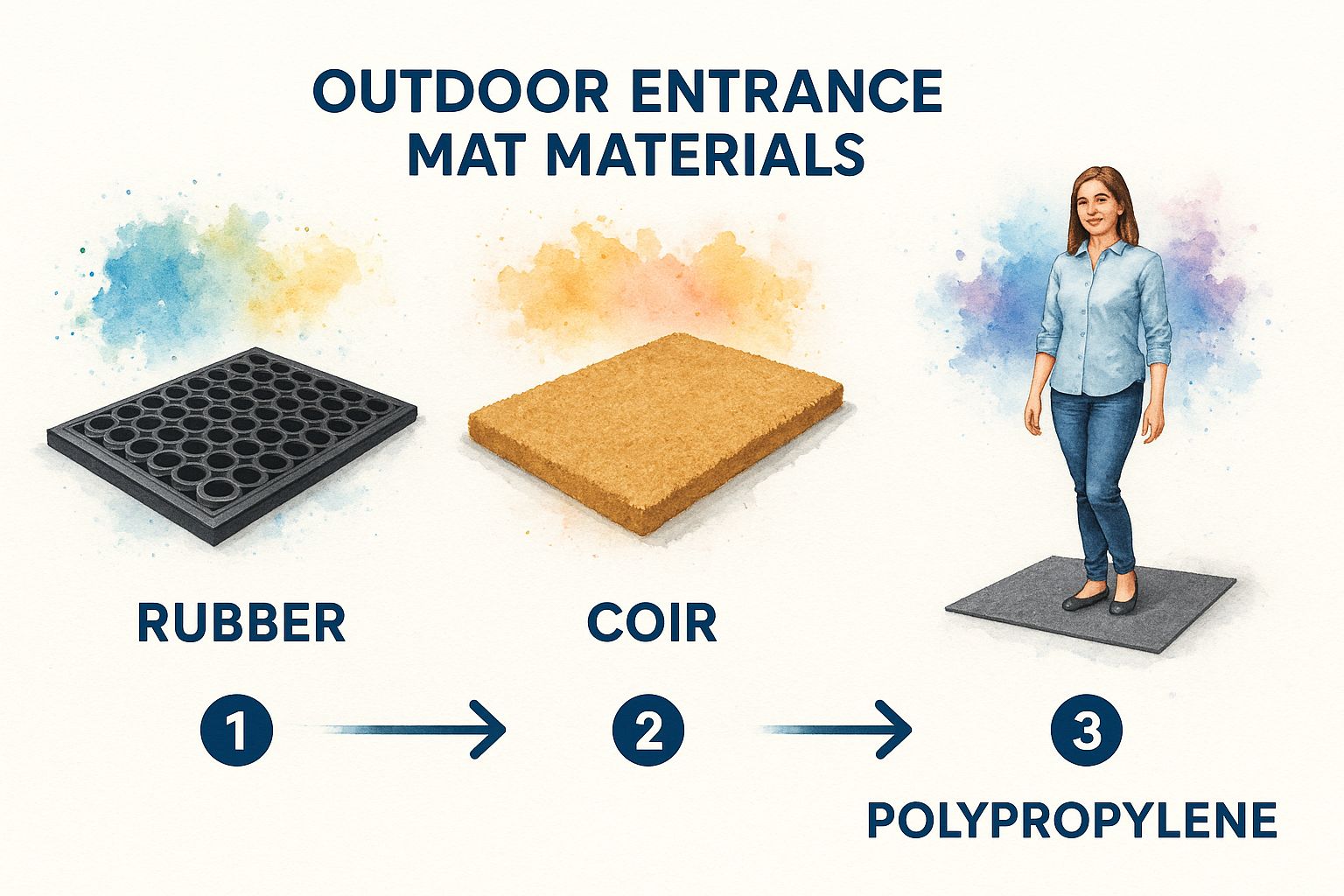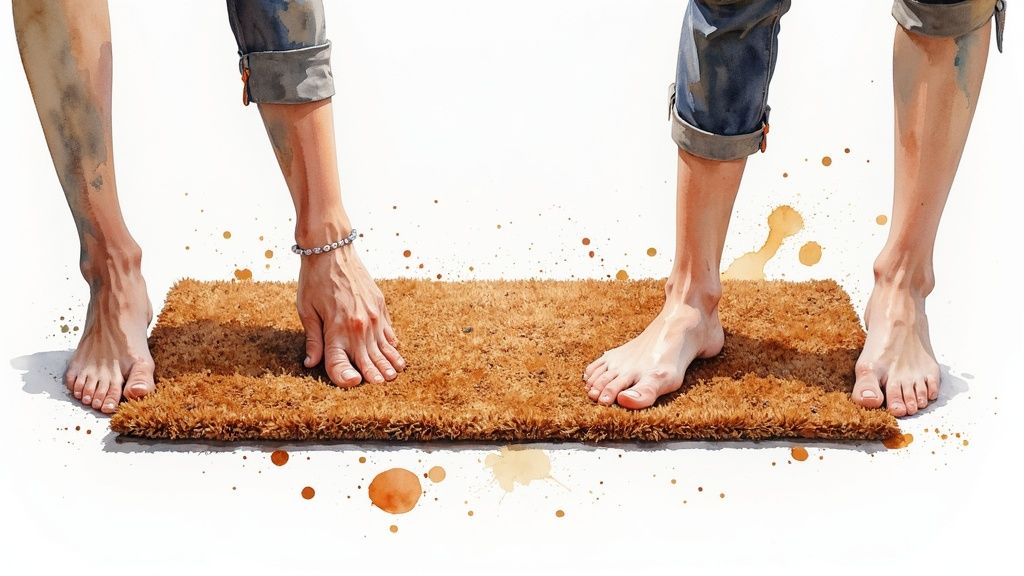An outdoor entrance mat is your building's first line of defense—and it's a critical one. This isn't just about having something to wipe your feet on. A high-quality mat is an active tool that scrapes shoes clean, traps dirt and moisture, and dramatically cuts down on the risk of slip-and-fall accidents. Choosing the right one directly impacts your maintenance budget, floor longevity, and overall safety. This guide provides actionable steps to help you select the perfect mat for your business.
Your First Defense Against Dirt and Debris

Think of your outdoor mat as the hardworking gatekeeper for your facility. Its main job is to aggressively stop heavy soil, mud, snow, and water before anyone even crosses the threshold. This single function creates a powerful ripple effect that protects your building's cleanliness and safety.
The impact is huge. Up to 80% of the dirt and moisture inside a building gets tracked in on the bottom of shoes. A proper outdoor mat intercepts the worst of it right at the door, which is why entrance mats are a must-have for every business.
How This Works in the Real World
To understand the benefit, let's look at a practical example.
Scenario: A busy downtown coffee shop on a rainy afternoon. Without a proper outdoor mat, every customer tracks in a mix of rainwater, street grit, and mud. This instantly creates two problems: a slippery floor that's a safety hazard and an endless cleaning cycle for staff who should be serving customers.
Solution: Now, imagine that same entrance but with a heavy-duty rubber scraper mat. Its aggressive, textured surface scrubs shoe soles clean, while deep channels trap the dirt and water.
The Direct Benefits:
- Increased Safety: The inside stays significantly drier and less slick, drastically lowering the risk of an accident and potential liability claims.
- Reduced Costs: Your team spends less time mopping and more time on core tasks. Plus, less abrasive grit gets ground into your expensive flooring, preventing long-term damage and replacement costs.
- Enhanced Brand Image: A clean, dry entrance looks more professional and welcoming, improving the customer experience from the first step.
This focus on safety and cleanliness is a big deal. The global outdoor entrance matting market was valued at USD 5.6 billion in 2023 and is projected to reach USD 8.7 billion by 2032. This isn't a niche product; it's a fundamental part of modern property management and maintenance.
Matching Mat Materials to Your Climate
Choosing the right material for your outdoor entrance mat is the single most important decision you'll make. It determines whether your mat succeeds or fails. An outdoor mat is in a constant battle with the elements; a material that works wonders in one climate can quickly crack, fade, or become a waterlogged mess in another. Getting this right from the start saves you the cost of premature replacements and keeps your entrance safe.
How to Choose for Harsh Winters and Heavy Rain
If your facility is in a region that gets significant rain, snow, and ice, you need a mat that provides aggressive scraping action and total resilience to moisture and freezing temperatures.
In this environment, heavy-duty rubber is the undisputed champion. Its tough, pliable structure won’t crack when the temperature plummets. The best rubber mats are designed with deep channels and raised cleats that act like tiny shovels, scraping thick mud and caked-on snow from boots. This debris gets trapped below the mat's surface, keeping it from being tracked inside.
Real-World Example: A manufacturing plant in a cold, snowy region places thick, perforated rubber scraper mats at every employee entrance.
- How they do it: They ensure the mats cover the entire entry path.
- The benefit: This simple step stops slush, snow, and corrosive de-icing salt right at the door. It drastically reduces interior wetness, prevents dangerous slips on the concrete floor, and protects their flooring from salt damage.
How to Choose for Intense Sun and Dry Heat
For climates with relentless sun, like those in Florida or Southern California, your biggest enemies are UV degradation and extreme heat. Direct sunlight will bleach the color out of lesser mats and cause certain materials to become brittle and fall apart.
Here, polypropylene is the superior choice. This synthetic fiber is solution-dyed, meaning the color is an integral part of the fiber itself, not just a surface coating. This makes it exceptionally resistant to fading. It also dries quickly and naturally resists mold and mildew, a huge plus for humid but sunny areas. Remember, while polypropylene offers great scraping, employees standing for long periods may need additional support. You can discover more about how specialized flooring supports staff well-being by checking out our guide on what anti-fatigue mats are.
Real-World Example: A beachfront resort in Miami uses polypropylene entrance mats with a heavy-duty rubber backing at all its poolside entrances.
- How they do it: They select mats with high UV resistance and a dark color to hide dirt.
- The benefit: These mats endure constant sun exposure without fading. They handle moisture from wet feet while always maintaining a clean, professional look for guests, protecting their investment and brand image.
A Quick-Reference Material Comparison
To make your decision easier, here’s a straightforward breakdown of how common materials perform.
| Material | Best for Cold/Snow | Best for Rain | Best for Sun/Heat | Key Weakness |
|---|---|---|---|---|
| Rubber | Excellent | Excellent | Good (can get hot) | Low-quality blends can crack |
| Polypropylene | Good | Excellent | Excellent | Can be less aggressive for heavy mud |
| Coir (Coconut Fiber) | Poor | Poor (retains water) | Fair (can shed) | Gets waterlogged and can rot |
| Vinyl | Good | Good | Fair (can fade) | Can become stiff in extreme cold |
Actionable Takeaway: Match the material’s strengths to your most common weather challenge. Prioritize its ability to stand up to your specific environment to ensure a long-lasting, effective solution.
How to Size Your Mat for Maximum Effect
You can pick the perfect material for your outdoor entrance mat, but it won't be effective if the size is wrong. A tiny mat is one of the most common and costly mistakes in facility management. If people only take one or two steps on the mat, it simply can’t do its job. The goal is to create a "capture zone" that ensures footwear is significantly cleaner and drier by the time someone steps inside.
The Essential Rule: Count the Footsteps
Here’s a practical rule to follow: ensure your outdoor mat is long enough for at least four to six footsteps. This gives each foot two to three solid scrapes to remove the worst of the grime. For width, the mat must be at least as wide as the doorway, or slightly wider. This prevents people from sidestepping it.
A Practical Example: A Hospital Entrance
Consider the main entrance of a busy hospital, with relentless foot traffic from visitors, patients, and staff. A standard 3x5 foot mat would be completely overwhelmed, creating an immediate safety risk.
A Better Strategy: Install a large, recessed outdoor scraper mat system covering the entire entryway, extending 10 to 15 feet from the door.
The Benefits of Proper Sizing:
- Improved Contaminant Control: Drastically cuts down on the dirt, water, and bacteria tracked into a sterile environment.
- Enhanced Safety: The interior lobby floor stays dry, which is critical for preventing slips for patients and staff with mobility challenges.
- Reduced Maintenance Costs: The custodial team spends far less time cleaning the entrance, freeing them up for other critical sanitation tasks.
This infographic breaks down how different mat types work together in a system.

As you can see, a complete system uses different materials for different jobs, from aggressive scraping outside to moisture absorption inside.
How to Create a Zoning System for Peak Performance
For the best results, pair your properly sized outdoor mat with an indoor wiper mat to create a highly effective zoning system.
- Zone 1 (Outdoor Scraper Mat): This mat does the heavy lifting, knocking off coarse dirt, mud, and snow.
- Zone 2 (Indoor Wiper Mat): As people step inside, this mat finishes the job by wiping away any remaining fine dust and absorbing leftover moisture.
It’s a one-two punch that keeps your floors pristine and safe.
Actionable Takeaway: Sizing isn't just about covering the ground; it's about creating a functional 'walk-off' zone that cleans shoes effectively. An investment in a larger outdoor entrance mat pays for itself through reduced cleaning costs and enhanced safety. This focus on performance is why the global entrance matting market was valued at $7.12 billion in 2024. For more details, you can read the full analysis.
Your Mat Maintenance and Safety Checklist
An outdoor entrance mat is a workhorse, but it can't do its job if it's clogged with the debris it's meant to trap. A neglected mat is more than ineffective; it can become a safety hazard. A consistent maintenance plan protects your investment and keeps your facility safe. This is about building simple, repeatable habits that extend the life of your mat and guarantee it’s working at its best.
How to Create a Practical Cleaning Schedule
A one-size-fits-all cleaning routine doesn't work. The right frequency depends on your mat's material and, most importantly, foot traffic.
- High-Traffic Industrial Example: A distribution center with constant foot traffic. For their rubber mats, a daily shake-out or vigorous brooming is essential. If they skip this, the mat's scraping channels clog by midday, rendering it useless and allowing debris inside.
- Moderate-Traffic Commercial Example: A corporate office or retail boutique. A thorough weekly cleaning is usually sufficient. The action plan is simple: take the mat outside, hose it down, and let it dry completely before putting it back.
For more techniques, our guide on 5 tips on how to keep your entrance mat clean offers more detailed, actionable advice.
The growing focus on cleanliness is a major force in the entrance matting industry, which was valued at around USD 6.61 billion in 2023. This shows how aware businesses are of the role these products play in maintaining clean and safe indoor spaces. You can learn more about these market insights from Grand View Research.
A Sample Maintenance Schedule You Can Use
Use this table as a starting point and adjust it based on the conditions at your entrances.
| Traffic Level | Daily Task | Weekly Task | Seasonal Task |
|---|---|---|---|
| High | Shake out, sweep, or vacuum to remove surface debris. | Hose down with a pressure washer; scrub with a stiff brush if needed. | Deep clean with an appropriate cleaning solution and inspect for wear. |
| Medium | Visually inspect for large debris and spot-clean as needed. | Thoroughly vacuum or shake out; hose down if visibly soiled. | Inspect backing and edges for cracking or curling. |
| Low | Quick visual check and sweep if necessary. | Shake out or vacuum to remove accumulated dust and dirt. | Full wash and dry; check for any signs of damage. |
The Critical Safety Inspection Checklist
Beyond cleaning, regular safety checks are crucial to prevent your mat from becoming a trip hazard. A damaged outdoor mat is a liability. Schedule a quick visual check at least once a week.
Here’s your actionable checklist:
- Check for Curled or Flipped Edges: This is the most common trip hazard. Ensure the mat lies perfectly flat.
- Inspect for Cracks or Tears: Check the mat's surface and backing for any splits, especially on rubber mats in extreme temperatures.
- Look for Buckling or Rippling: Ensure the mat is sitting flush with the ground so it cannot catch a foot, cane, or cartwheel.
- Assess for Excessive Wear: A mat that is visibly worn down has lost its texture and is no longer effective at scraping shoes.
Actionable Takeaway: If you spot any of these issues, act immediately. Significant damage means the mat must be replaced. Ignoring these warning signs puts your visitors and employees at risk and opens you up to liability.
Using Custom Mats to Boost Your Brand
Think of your outdoor entrance mat as the first handshake a visitor has with your business. It's an opportunity to go beyond pure function and turn a necessary item into a powerful branding tool. A great mat sets a professional tone from the very first step.

This isn't just about adding a logo. A thoughtfully designed custom mat reinforces your brand identity, communicates professionalism, and makes a memorable first impression. It becomes a seamless part of your building's aesthetic and marketing strategy.
How to Design a Mat That Actually Works
A cluttered, hard-to-read design is a wasted opportunity. A clean, striking mat, on the other hand, instantly elevates your entryway.
Real-World Example: A high-end corporate headquarters would never settle for a mat with a fuzzy, low-resolution logo. They would insist on a high-contrast design where the logo is crisp and instantly recognizable against a solid background. That is the goal.
Follow these actionable design steps:
- Ensure Logo Clarity: Keep it simple. Intricate details and tiny text become illegible once dirty. Use a simplified or "knockout" version of your logo if you have one.
- Simplify the Message: Less is more. A powerful logo is more impactful than a tagline or phone number that will be covered by foot traffic.
- Use High Contrast: This is non-negotiable. Choose colors that make your logo pop. A dark grey mat with a bright white logo is far more effective than a brown mat with a black logo.
How to Choose Smart, Practical Colors
Picking colors for your custom mat is a strategic balancing act between brand consistency and practicality. The colors must hide dirt and grime between cleanings.
Actionable Insight: The most successful branded mats use a darker, neutral field color—like charcoal, deep blue, or forest green—as the base. This background is brilliant at camouflaging dirt, which allows your brighter, brand-accurate logo color to stand out and stay sharp.
Real-World Example: A tech company with a vibrant blue and white brand could choose a charcoal gray mat.
- How they do it: They select the dark gray base to match their modern aesthetic while providing a practical function.
- The benefit: The dark base hides tracked-in mess, while their bold blue and white logo remains crisp and professional. This turns a functional necessity into a seamless branding moment. To dig deeper, learn why you should invest in branded mats in our detailed guide.
Your outdoor mat is a silent ambassador for your brand. By prioritizing a clear design and smart color choices, you transform it from a basic doormat into a sophisticated welcome that signals your commitment to quality.
Your Outdoor Entrance Mat Questions, Answered
Even with all the specs, practical questions arise when you're ready to purchase a new mat. Here are actionable answers to the most common questions from facility managers and business owners.
How Do I Stop My Mat from Sliding Around?
A sliding mat is a serious trip hazard. The problem is usually a mismatch between the mat’s backing and the floor surface. A smooth vinyl-backed mat on polished concrete, for example, offers zero grip.
How to fix it:
- Get the Right Backing: For slick surfaces like tile or polished concrete, you need a cleated rubber backing. The rubber nubs dig in just enough to create friction and anchor the mat.
- Use Mat Gripper Tape: For lighter mats or in lower-traffic areas, double-sided mat tape or specialty gripper pads can be applied to the underside to add grip.
Real-World Example: A dental office's welcome mat was constantly shifting on their tiled entryway. This was a significant risk for patients. They switched to a heavy-duty rubber mat with a cleated back, and the problem was solved instantly, making the entrance safer for everyone.
Can I Just Use an Indoor Mat Outside?
The answer is a firm no. Indoor and outdoor mats are engineered for completely different jobs. An indoor mat has soft, absorbent fibers—like carpet—meant to grab fine dust and moisture from shoes that are already mostly clean.
If you put that mat outside, it will be destroyed by UV sunlight, rain, and coarse grit. It will become waterlogged in the first storm, the colors will fade in weeks, and the material will quickly break down. It lacks the rugged, weather-proof build of a true outdoor mat.
Actionable Takeaway: Only use mats specifically engineered for the outdoors. They are made from materials like tough rubber or UV-stabilized polypropylene that can withstand the elements and aggressively scrape shoes for years.
When Should I Replace My Mat?
Knowing when to replace an old mat is key to keeping your entryway safe. A worn-out mat is often more hazardous than no mat at all.
Here are the tell-tale signs it's time for a replacement:
- Visible Damage: If you see cracks, tears, or missing chunks, the mat is finished.
- Curled Edges: When edges curl up and won't lie flat, the mat has become an active trip hazard and must be replaced.
- Worn-Down Surface: Run your hand over the top. If the aggressive scraping texture has gone smooth, it is no longer cleaning shoes effectively.
- Failing Backing: Flip it over. If the rubber or vinyl backing is cracking, crumbling, or peeling, the mat has lost its stability and grip.
Don't wait for a slip-and-fall incident. Proactively replacing a worn-out mat is one of the smartest and most cost-effective safety investments you can make.
Ready to find the perfect outdoor entrance mat that protects your floors and boosts your brand? The team at Mats4U has over 50 years of experience helping businesses choose the right solution. Explore our collection of high-performance mats and find the ideal fit for your facility at https://www.mats4u.com.







